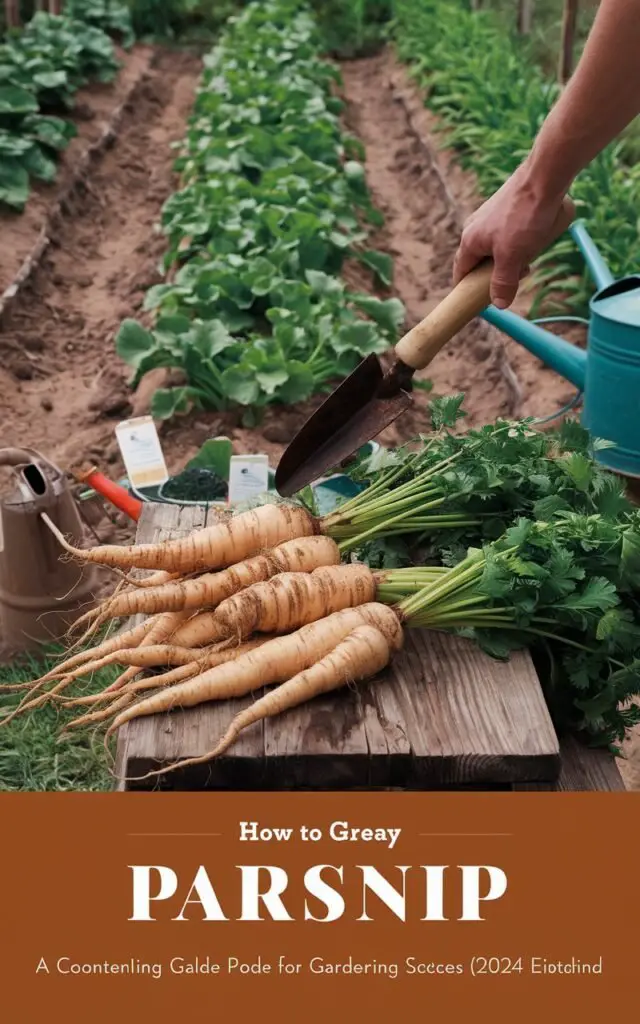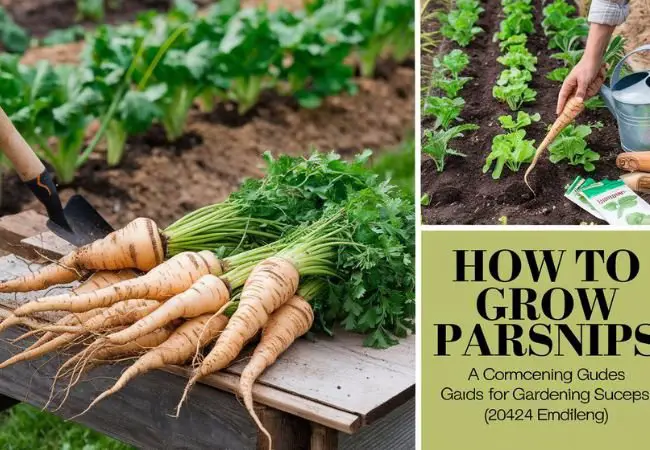Learn how to grow delicious parsnips with our expert 2024 guide. Discover soil preparation tips, planting techniques and care instructions for a bountiful harvest. Perfect for beginners and experienced gardeners alike!
Parsnips are delightful root vegetables that offer a sweet, nutty flavor when properly grown and harvested. These often-overlooked gems of the garden can be a rewarding addition to your vegetable patch, providing a nutritious and versatile crop for your kitchen. In this comprehensive guide, we’ll walk you through the process of growing parsnips, from seed selection to harvest, ensuring you have all the knowledge needed for a successful crop.
As a horticulturist with over two decades of experience in vegetable gardening, I’m excited to share my expertise on growing these tasty root vegetables. Let’s dive into the world of parsnip cultivation and unlock the secrets to a bountiful harvest!
Why Grow Parsnips?

Before we get into the how-to, let’s consider the benefits of growing parsnips:
- They’re packed with nutrients, including fiber, vitamins, and minerals
- They have a long growing season, providing fresh vegetables well into winter
- They improve soil structure with their deep taproots
- They have a unique, sweet flavor that intensifies after frost
- They’re relatively low-maintenance once established
Now, let’s explore the step-by-step process of growing parsnips.
Step-by-Step Guide to Growing Parsnips
1. Choose the Right Variety
Why It’s Important: Selecting the appropriate variety ensures success in your specific climate and growing conditions.
How to Do It:
- Research varieties suitable for your region
- Consider factors like disease resistance and root length
2024 Trend: Climate-adaptive vegetable varieties are gaining popularity as gardeners face changing weather patterns.
Pro Tip: ‘Hollow Crown’ and ‘Gladiator’ are reliable varieties for beginners.
2. Prepare the Soil
Why It’s Important: Parsnips require deep, well-draining soil for proper root development.
How to Do It:
- Choose a sunny location with loose, fertile soil
- Remove rocks and debris to a depth of at least 12 inches
- Incorporate organic matter to improve soil structure
2024 Update: New soil amendments specifically formulated for root vegetables are entering the market.
Pro Tip: Consider raised beds if your native soil is heavy clay or rocky.
3. Time Your Planting
Why It’s Important: Proper timing ensures optimal growing conditions for parsnips.
How to Do It:
- Sow seeds directly in the garden in early spring
- Plant when soil temperatures reach 40°F (4°C)
2024 Innovation: Smart soil thermometers with app connectivity are helping gardeners time planting more precisely.
Pro Tip: In warmer climates, consider a fall planting for a winter harvest.
4. Sow the Seeds
Why It’s Important: Proper seed sowing is crucial for good germination and spacing.
How to Do It:
- Create shallow furrows about 1/2 inch deep
- Space rows 18-24 inches apart
- Sow seeds 1 inch apart within the row
- Cover lightly with soil and water gently
2024 Trend: Biodegradable seed tapes are becoming popular for easier and more precise sowing.
Pro Tip: Parsnip seeds lose viability quickly; always use fresh seeds for best results.
5. Provide Proper Care
Why It’s Important: Consistent care ensures healthy growth and development.
How to Do It:
- Keep soil consistently moist until germination (which can take up to 3 weeks)
- Once seedlings emerge, thin to 3-4 inches apart
- Water deeply and regularly, especially during dry spells
- Mulch to retain moisture and suppress weeds
2024 Update: Drought-tolerant parsnip varieties are being developed for water-conscious gardening.
Pro Tip: Use row covers to protect young seedlings from pests and harsh weather.
6. Fertilize Appropriately
Why It’s Important: Proper nutrition supports healthy root development.
How to Do It:
- Apply a balanced, organic fertilizer before planting
- Side-dress with compost mid-season
2024 Research: Studies are exploring the impact of micronutrients on parsnip flavor development.
Pro Tip: Avoid high-nitrogen fertilizers, which can lead to forked roots.
7. Manage Pests and Diseases
Why It’s Important: Proactive management ensures a healthy crop.
How to Do It:
- Monitor for common pests like carrot rust flies and aphids
- Watch for diseases such as canker and leaf spot
- Practice crop rotation to prevent soil-borne issues
2024 Innovation: Integrated pest management (IPM) apps are providing real-time pest alerts and treatment recommendations.
Pro Tip: Companion plant with onions or garlic to deter pests naturally.
8. Harvest at the Right Time
Why It’s Important: Proper harvesting ensures the best flavor and texture.
How to Do It:
- Harvest parsnips after 120-180 days, typically after the first frost
- Use a garden fork to gently lift roots from the soil
- Twist off tops and brush off excess soil
2024 Trend: “Frost-kissed” vegetables, including parsnips, are gaining gourmet status in culinary circles.
Pro Tip: Leave some parsnips in the ground (mulched) for an extended harvest throughout winter.
Best Practices for Growing Parsnips
To ensure the best results when growing parsnips:
- Practice patience – parsnips are slow growers but worth the wait
- Maintain consistent soil moisture to prevent splitting
- Consider interplanting with quick-growing crops like radishes to maximize space
- Keep garden beds weed-free to reduce competition for nutrients
- Store harvested parsnips in a cool, humid environment for extended shelf life
Embracing the Parsnip’s Potential
Growing parsnips may require some patience, but the reward of pulling these sweet, nutty roots from your own garden is unmatched. By following this guide and adapting to your local conditions, you’ll be well on your way to parsnip success.
Remember, gardening is a journey of continuous learning. Don’t be discouraged if your first crop isn’t perfect – each season brings new opportunities to refine your techniques and connect with your food.
For more information on vegetable gardening and sustainable practices, visit resources like the National Gardening Association or your local cooperative extension office. Happy growing, and may your parsnip harvest be plentiful and delicious!
For more gardening tips and plant care guides, visit usagardenhub.com.





